Take Charge of Your Health - Abortion Facts and Trends
Rather than focusing on reducing abortion, policies should instead center the needs of people and protect their right to bodily autonomy.
-Guttmacher Institute
With the recent repeal of Roe v Wade, abortion has been making headlines in new and complicated ways. We thought about how abortion has changed during our own lives and about the misinformation that seems rampant regardless of which side of the discussion you find yourself. As with the other medical issues we present in this blog, we think it is also important to bring information to you about abortion trends and actual procedures believing that it might be useful as we each come to our own decisions.
First, looking at overall trends in abortion over the past 30 years, rates have been consistently falling as can be seen in this chart 2022 from the Guttmacher Institute.
That said, over the past five years the data becomes a bit murky. While the trend has shown an uptick from 2017 to 2020 (the last years of reported data), it is unclear whether it is from an overall decrease in the birthrate or a renewed interest in abortion. As with most things it is hard to pinpoint an exact explanation and factors such as changing insurance coverage by private or governmental programs and the COVID pandemic certainly seems to have had an effect. Additionally, changing laws in specific states caused migration of abortion care to neighboring states in greater numbers than ever before. Unfortunately, there are no simple explanations.
As far as approved clinical procedures go, abortion generally occurs by one of two methods: aspiration or medication. Aspiration abortion is a brief procedure performed by a clinician that opens the cervix and uses a vacuum to expunge the uterus. Since its approval by the FDA in 2020 medication abortion is currently being used in over half of U. S. cases and works with the combination of two drugs. The first drug is called milepristone and stops the pregnancy from growing; the second medication is called misoprostol and is taken up to 48 hours after the first one and works to shed the lining of the uterus. It is important to note that there is no clinical evidence that either mechanism limits a woman's ability to have a child in the future.
Sometimes people are confused about the "morning after" pill or "Plan B" as it is sometimes called. This over-the-counter-drug is made up of levonorgestrel and acts in the following ways: preventing the release of an egg from the ovary, prevention of sperm fertilizing an egg, and preventing the fertilized egg from implanting in the uterus. The prescription drug Ella consists of ulipristal acetate and prevents pregnancy if taken within 5 days of unprotected sex. Neither of these medications is formally part of the abortion discussion because they are taken in advance of any pregnancy.
These are difficult times for women across the globe as more and more attention is given to bodily control and reproductive freedom. It is an important discussion with serious implications both on personal and societal levels and it behooves all of us to become better educated and have our voice be heard.

